Inverse Contrast in Non-Destructive Materials Research by Using Active Thermography
Abstract
1. Introduction
2. Materials and Methods
- Tp(t)—the temperature on a surface point of the cross-section with a defect [°C],
- Tpj(t)—the temperature on a surface point of the homogeneous cross section without a defect [°C].
3. Results
3.1. Thermograms
3.2. Absolute Contrasts
4. Discussion
4.1. Absolute Contrasts and Absolute Inverse Contrasts
4.2. Defect Location Depth
- —the thermal conductivity of the tested material (above the defect) [W·m−1·K−1],
- —the time elapsed since the end of heating [s],
- —the bulk density of the tested material (above the defect) [kg·m−3],
- —the specific heat of the tested material (above the defect) [J·kg−1·K−1],
- —the relative contrast in relation to the reference area (the cross section with the defect) [-].
4.3. Dimensions of the Defect
5. Conclusions
- Using the non-destructive active thermography technique, one can locate material inclusions in building partitions (elements with a large thermal capacity), situated at a depth of at least 22 mm below the surface of cladding made of wood or gypsum;
- In order to locate defects in a building partition, it is sufficient to heat its surface to about 60 °C whereby the test does not lose its non-destructive character;
- The highest temperature contrasts between the cross sections with defects and the cross sections without defects (the inclusions are most clearly visible then) arise at the time interval from the 15th to the 40th min since the beginning of cooling down;
- During testing in the reflection mode, inclusions with a considerably higher heat capacity than that of the basic materials are visible as areas whose temperature is lower than that of the areas without inclusions;
- During testing in the reflection mode, inclusions with a considerably lower heat capacity than that of the basic materials are visible as areas whose temperature is higher than that of the areas without inclusions;
- During testing in the transmission mode, the areas with defects are visible as areas whose temperature is higher than that of the areas without inclusions, regardless of the heat capacity of the material inclusions;
- Approximately 90 min after the heating source is switched off, the second phase of cooling down takes place. In this phase, an inverse absolute contrast appears—the sign of the contrast changes and the inclusions initially visible as a warmer area are perceived as cooler areas, and vice versa (this phenomenon occurs on the same side of the partition);
- Using the Echo Defect Shape method, one can successfully (with an error below 10%) determine the depth at which a defect is located in the building partition;
- Knowing the specifications of the thermal imaging camera lens (the size [in mm] of 1 pixel in the thermogram), one can estimate the size of the defects present inside the partition by indicating the place in the thermogram where the defect’s edges are likely situated.
Author Contributions
Acknowledgments
Conflicts of Interest
References
- Maierhofer, C.; Reinhardt, H.W.; Dobmann, G. Non-Destructive Evaluation of Reinforced Concrete Structures—Non-Destructive Testing Methods; Woodhead Publishing: Cambridge, UK, 2010; Volume 2, ISBN 978-18-4569-950-5. [Google Scholar]
- Hoła, J.; Bień, J.; Sadowski, Ł.; Schabowicz, K. Non-destructive and semi-destructive diagnostics of concrete structures in assessment of their durability. Bull. Pol. Acad. Sci. 2015, 63, 87–96. [Google Scholar] [CrossRef]
- Lüthi, T. Non-Destructive Evaluation Methods. EMPA—Swiss Federal Laboratories for Materials Science and Technology; Self-Published: Dübendorf, Switzerland, 2013. [Google Scholar]
- Balageas, D.; Maldague, X.; Burleigh, D.; Vavilow, V.P.; Oswald-Tranta, B.; Roche, J.M.; Pradere, C.; Carlomagno, G.M. Thermal (IR) and Other NDT Techniques for Improved Material Inspection. J. Nondestruct. Eval. 2016, 35, 18. [Google Scholar] [CrossRef]
- Nowak, H. Application of Infrared Thermography in Construction; Wrocław University of Science and Technology Publishing House: Wrocław, Poland, 2012; ISBN 978-83-7493-676-7. (In Polish) [Google Scholar]
- Barreira, E.; Freitas, V.P. Evaluation of building materials using infrared thermography. Constr. Build. Mater. 2007, 21, 218–224. [Google Scholar] [CrossRef]
- Barreira, E.; Almeida, R.M.S.F.; Delgado, J.M.P.Q. Infrared thermography for assessing moisture related phenomena in building components. Constr. Build. Mater. 2016, 110, 251–269. [Google Scholar] [CrossRef]
- Wróbel, A.; Kisilewicz, T. Detection of thermal bridges—Aims, possibilities and conditions. In Proceedings of the QIRT 2008 Proceedings—9-th Quantitative InfraRed Thermography—International Conference, Krakow, Poland, 2–5 July 2008; pp. 227–232, ISBN 978-83-908655-1-5. [Google Scholar]
- Kisilewicz, T.; Wróbel, A. Quantitative infrared wall inspection. In Proceedings of the 10-th Edition of the Quantitative InfraRed Thermography—International Conference, Québec-City, QC, Canada, 27–30 June 2010; pp. 589–594, ISBN 978-2-9809199-1-6. [Google Scholar]
- Khodayar, F.; Sojasi, S.; Maldague, X. Infrared thermography and NDT: 2050 horizon. Quant. Infrared Thermogr. J. 2016, 13, 210–231. [Google Scholar] [CrossRef]
- Vavilov, V. Thermal NDT: Historical milestones, state-of-the-art and trends. Quant. Infrared Thermogr. J. 2014, 11, 66–83. [Google Scholar] [CrossRef]
- Wu, D.; Karpen, W.; Busse, G. Lockin thermography for multiplex photothermal nondestructive evaluation. In Proceedings of the QIRT Conference, Paris, France, 7–9 July 1992. [Google Scholar]
- Ibarra-Castanedo, C.; Piau, J.M.; Guilbert, S.; Avdelidis, N.P.; Genest, M.; Bendada, A.; Maldague, X. Comparative Study of Active Thermography Techniques for the Nondestructive Evaluation of Honeycomb Structures. Res. Nondest. Eval. 2009, 20, 1–31. [Google Scholar] [CrossRef]
- Maierhofer, C.; Myrach, P.; Steinfurth, H.; Reischel, M.; Röllig, M. Development of standards for flash thermography and lock-in thermography. In Proceedings of the 14th International Conference on Quantitative InfraRed Thermography (QIRT14), Bordeaux, France, 7–11 July 2014. [Google Scholar]
- Dudzik, S. Determining the Depth of Material Defects by Means of Dynamic Active Thermography and Artificial Neural Networks; Częstochowa University of Technology Publishing House: Częstochowa, Poland, 2013; ISBN 978-83-7193-572-5. (In Polish) [Google Scholar]
- Palumbo, D.; Galietti, U. Damage Investigation in Composite Materials by Means of New Thermal Data Processing Procedures. Strain 2016, 52, 276–285. [Google Scholar] [CrossRef]
- Palumbo, D.; Cavallo, P.; Galietti, U. An investigation of the stepped thermography technique for defects evaluation in GFRP materials. NDT E Int. 2019, 102, 254–263. [Google Scholar] [CrossRef]
- Maldague, X. Theory and Practice of Infrared Technology of Non-Destructive Testing; John Wiley & Sons: New York, NY, USA, 2001; ISBN 978-0-471-18190-3. [Google Scholar]
- EN 17119:2018 Non-Destructive Testing—Thermographic Testing—Active Thermography; European Standard: Brussels, Belgium, 2018.
- Milovanović, B.; Banjad Pečur, I. Review of Active IR Thermography for Detection and Characterization of Defects in Reinforced Concrete. J. Imaging 2016, 2, 11. [Google Scholar] [CrossRef]
- Arndt, R.W. Square pulse thermography in frequency domain as adaptation of pulsed phase thermography for qualitative and quantitative applications in cultural heritage and civil engineering. Infrared Phys. Technol. 2010, 53, 246–253. [Google Scholar] [CrossRef]
- Ibarra-Castanedo, C.; Sfarra, S.; Klein, M.; Maldague, X. Solar loading thermography: Time-lapsed thermographic survey and advanced thermographic signal processing for the inspection of civil engineering and cultural heritage structures. Infrared Phys. Technol. 2017, 82, 56–74. [Google Scholar] [CrossRef]
- Noszczyk, P.; Nowak, H. Active thermography as a state-of-the-art method of testing reinforced concrete units (in Polish). J. Civ. Eng. Environ. Arch. 2016, 33, 279–286. [Google Scholar] [CrossRef]
- Maierhofer, C.; Brink, A.; Röllig, M.; Wiggenhauser, H. Quantitative impulse-thermography as non-destructive testing method in civil engineering—Experimental results and numerical simulations. Constr. Build. Mater. 2005, 19, 731–737. [Google Scholar] [CrossRef]
- Maierhofer, C.; Arndt, R.; Röllig, M.; Rieck, C.; Walther, A.; Scheel, H.; Hillemeier, B. Application of impulse-thermography for non-destructive assessment of concrete structures. Cem. Conrete Compos. 2006, 28, 393–401. [Google Scholar] [CrossRef]
- Weiser, M.; Röllig, M.; Arndt, R.; Erdmann, B. Development and test of a numerical model for pulse thermography in civil engineering. Heat Mass Transf. 2010, 46, 1419–1428. [Google Scholar] [CrossRef]
- Maierhofer, C.; Brink, A.; Röllig, M.; Wiggenhauser, H. Transient thermography for structural investigation of concrete and composites in the near surface region. Infrared Phys. Technol. 2002, 43, 271–278. [Google Scholar] [CrossRef]
- Maierhofer, C.; Wiggenhauser, H.; Brink, A.; Röllig, M. Quantitative numerical analysis of transient IR-experiments on buildings. Infrared Phys. Technol. 2004, 46, 173–180. [Google Scholar] [CrossRef]
- Maierhofer, C.; Brink, A.; Röllig, M.; Wiggenhauser, H. Detection of shallow voids in concrete structures with impulse thermography and radar. NDT E Int. 2003, 36, 257–263. [Google Scholar] [CrossRef]
- Khan, F.; Bolhassani, M.; Kontsos, A.; Hamid, A.; Bartoli, I. Modeling and experimental implementation of infrared thermography on concrete masonry structures. Infrared Phys. Technol. 2015, 69, 228–237. [Google Scholar] [CrossRef]
- Donatelli, A.; Aversa, P.; Luprano, V.A.M. Set-up of an experimental procedure for the measurement of thermal transmittances via infrared thermography on lab-made prototype walls. Infrared Phys. Technol. 2016, 79, 135–143. [Google Scholar] [CrossRef]
- Rumbayan, R.; Washer, G.A. Modeling of Environmental Effects on Thermal Detection of Subsurface Damage in Concrete. Res. Nondest. Eval. 2014, 25, 235–252. [Google Scholar] [CrossRef]
- Sfarra, S.; Marcucci, E.; Ambrosini, D.; Paoletti, D. Infrared exploration of the architectural heritage: From passive infrared thermography to hybrid infrared thermography (HIRT) approach. Mater. Constr. 2016, 66, 94. [Google Scholar] [CrossRef]
- Aggelis, D.G.; Kordatos, E.Z.; Strantza, M.; Soulioti, D.V.; Matikas, T.E. NDT approach for characterization of subsurface cracks in concrete. Constr. Build. Mater. 2011, 25, 3089–3097. [Google Scholar] [CrossRef]
- Lai, W.W.-L.; Lee, K.-K.; Poon, C.-S. Validation of size estimation of debonds in external wall’s composite finishes via passive Infrared thermography and a gradient algorithm. Constr. Build. Mater. 2015, 7, 113–124. [Google Scholar] [CrossRef]
- Kurita, K.; Oyado, M.; Tanaka, H.; Tottori, S. Active infrared thermographic inspection technique for elevated concrete structures using remote heating system. Infrared Phys. Technol. 2009, 52, 208–213. [Google Scholar] [CrossRef]
- Halabe, U.B.; Vasudevan, A.; Klinkhachorn, P.; GangaRao, H.V.S. Detection of subsurface defects in fiber reinforced polymer composite bridge decks using digital infrared thermography. Nondestruct. Test. Eval. 2007, 22, 155–175. [Google Scholar] [CrossRef]
- Keo, S.A.; Brachelet, F.; Breaban, F.; Defer, D. Steel detection in reinforced concrete wall by microwave infrared thermography. NDT E Int. 2014, 62, 172–177. [Google Scholar] [CrossRef]
- Cotič, P.; Kolarič, D.; Bosiljkov, V.B.; Bosiljkov, V.; Jagličić, Z. Determination of the applicability and limits of void and delamination detection in concrete structures using infrared thermography. NDT E Int. 2015, 74, 87–93. [Google Scholar] [CrossRef]
- Scott, M.; Kruger, D. Infrared Thermography as a Diagnostic Tool for Subsurface Assessments of Concrete Structures. In Proceedings of the ITC User Conference, Stockholm, Sweden, 29–30 October 2014. [Google Scholar]
- Scott, M.; Kruger, D. Effects of Solar Loading on the Limits of Predictability of Internal Delamination Defects in Concrete Using Infrared Thermography. In Proceedings of the Conference InfraMation, Orlando, FL, USA, 4–7 November 2013. [Google Scholar]
- Brachelet, F.; Keo, S.; Defer, D.; Breaban, F. Detection of reinforcement bars in concrete slabs by infrared thermography and microwaves excitation. In Proceedings of the Conference QIRT, Bordeaux, France, 7–11 July 2014. [Google Scholar]
- Brink, A.; Maierhofer, C.; Röllig, M.; Wiggenhauser, H. Application of quantitative impulse thermography for structural evaluation in civil engineering—Comparison of experimental results and numerical simulations. In Proceedings of the 6th Quantitative InfraRed Thermography Conference, Dubrovnik, Croatia, 24–27 September 2002. [Google Scholar]
- Arndt, R.; Maierhofer, C.; Röllig, M.; Weritz, F.; Wiggenhauser, H. Structural Investigation of Concrete and Masonry Structures behind Plaster by means of Pulse Phase Thermography. In Proceedings of the 7th International Conference on Quantitative Infrared Thermography (QIRT), Brussels, Belgium, 5–8 July 2004. [Google Scholar]
- Vavilov, V.P.; Pan, Y.; Moskovchenko, A.I.; Čapka, A. Modeling, detecting and evaluating water ingress in aviation honeycomb panels. Quant. Infrared Thermogr. J. 2017, 14, 206–217. [Google Scholar] [CrossRef]
- Lai, W.L.; Poon, C.-S. Boundary and size estimation of debonds in external wall finishes of high-rise buildings using Infrared thermography. In Proceedings of the QIRT2012—11th international conference on quantitative infrared thermography, Naples, Italy, 11–14 June 2012. [Google Scholar]
- Vavilov, V.P.; Burleigh, D.D. Review of pulsed thermal NDT: Physical principles, theory and data processing. NDT E Int. 2015, 73, 28–52. [Google Scholar] [CrossRef]
- Szymanik, B.; Frankowski, P.K.; Chady, T.; John Chelliah, C.R.A. Detection and Inspection of Steel Bars in Reinforced Concrete Structures Using Active Infrared Thermography with Microwave Excitation and Eddy Current Sensors. Sensors 2016, 16, 234. [Google Scholar] [CrossRef]
- Lugin, S.; Netzelmann, U. A defect shape reconstruction algorithm for pulsed thermography. NDT E Int. 2007, 40, 220–228. [Google Scholar] [CrossRef]
- Richter, R.; Maierchofer, C.; Kreutzbruck, M. Numerical method of active thermography for the reconstruction of back wall geometry. NDT E Int. 2013, 54, 189–197. [Google Scholar] [CrossRef]
- Vavilov, V. Infrared Techniques for Materials Analysis and Nondestructive Testing. In Infrared Methodology and Technology; Maldague, X.P.V., Ed.; Gordon and Breach Publishers: London, UK, 1994; pp. 230–309. [Google Scholar]
- Balageas, D.L.; Roche, J.M.; Leroy, H. Comparative Assessment of Thermal NDT Data Processing Techniques for Carbon Fiber Reinforced Polymers. Mater. Eval. 2017, 75, 1019–1031. [Google Scholar]
- Giorleo, G.; Meola, C. Comparison between pulsed and modulated thermography in glass-epoxy laminates. NDT E Int. 2002, 35, 287–292. [Google Scholar] [CrossRef]
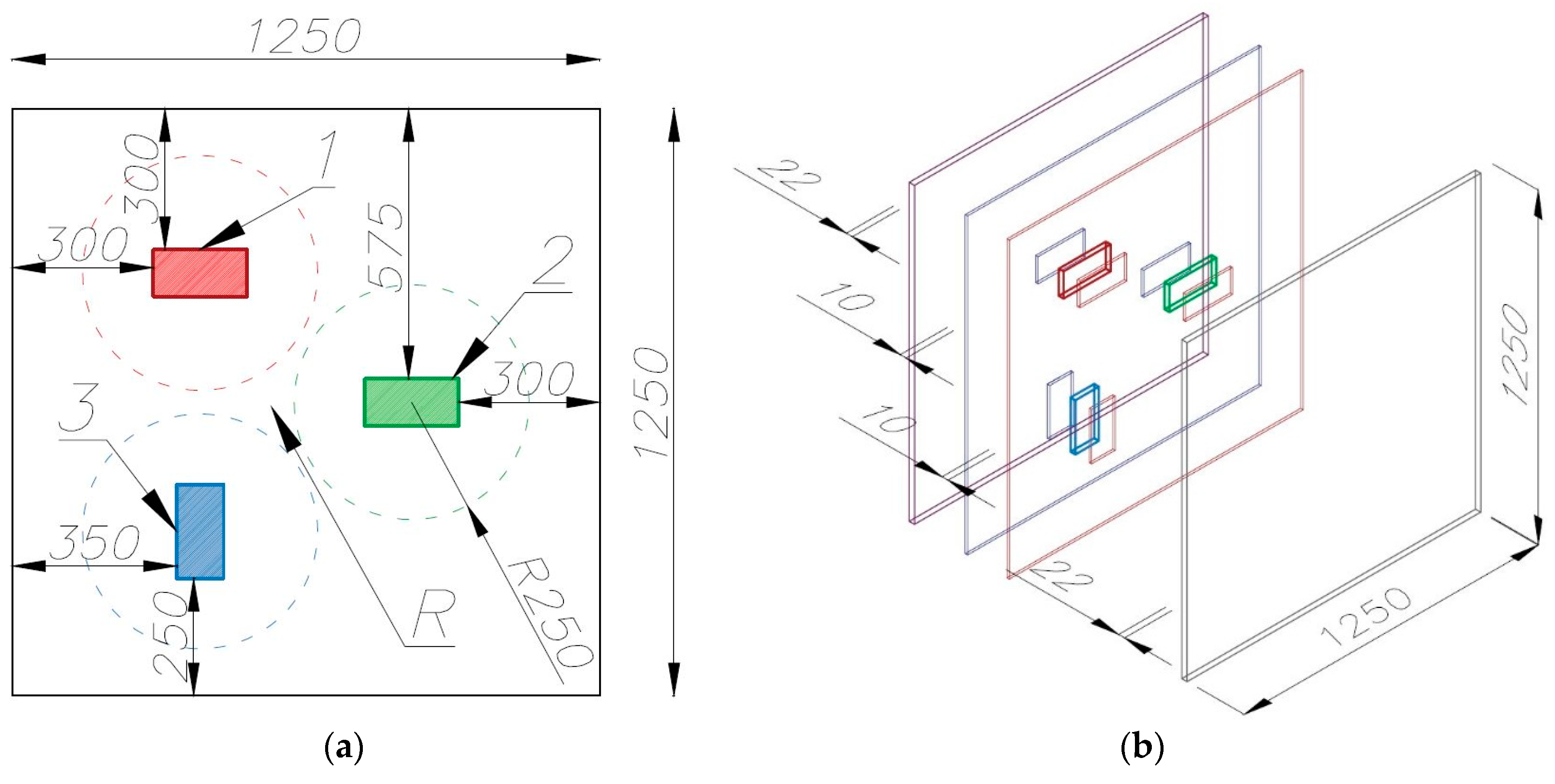


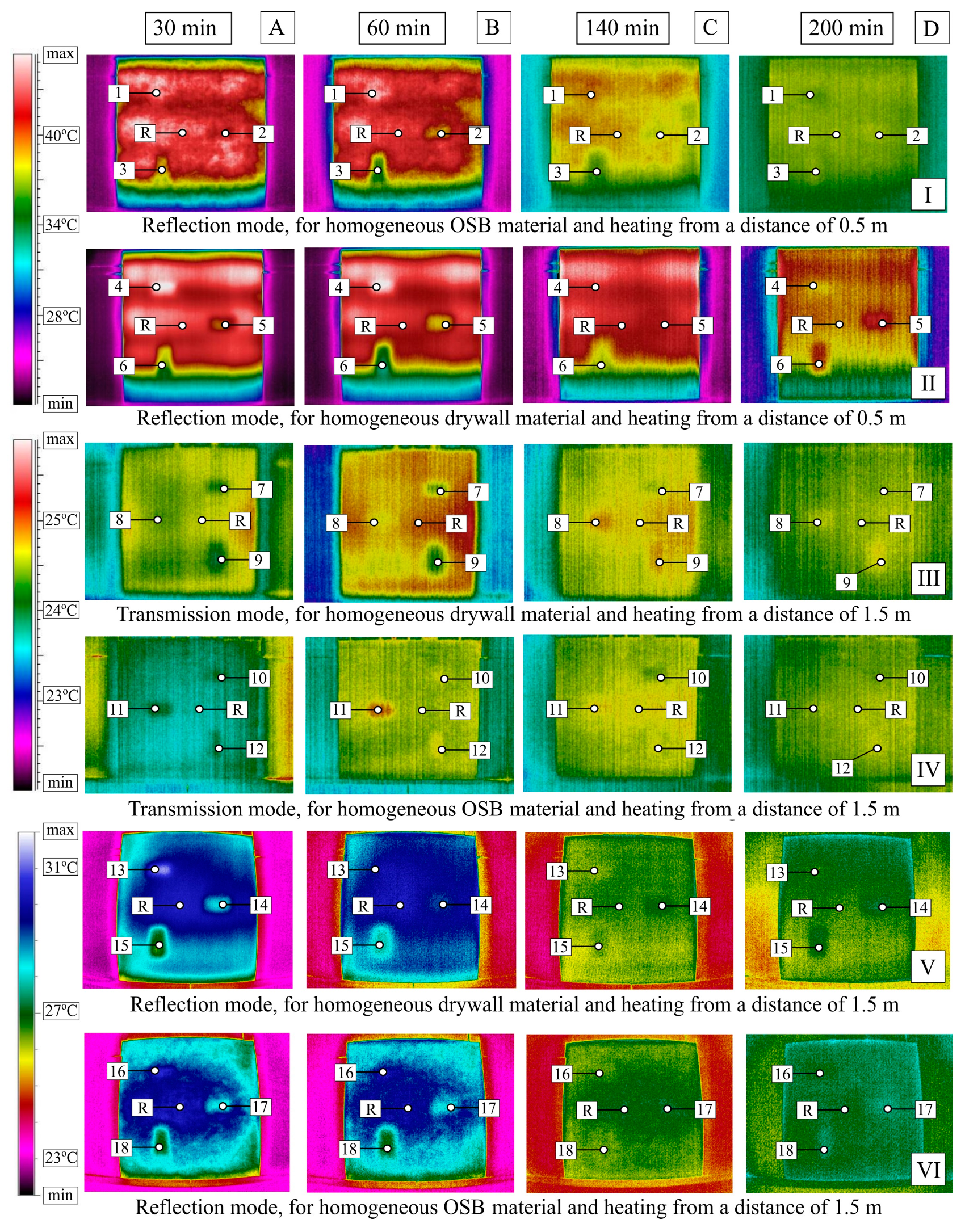
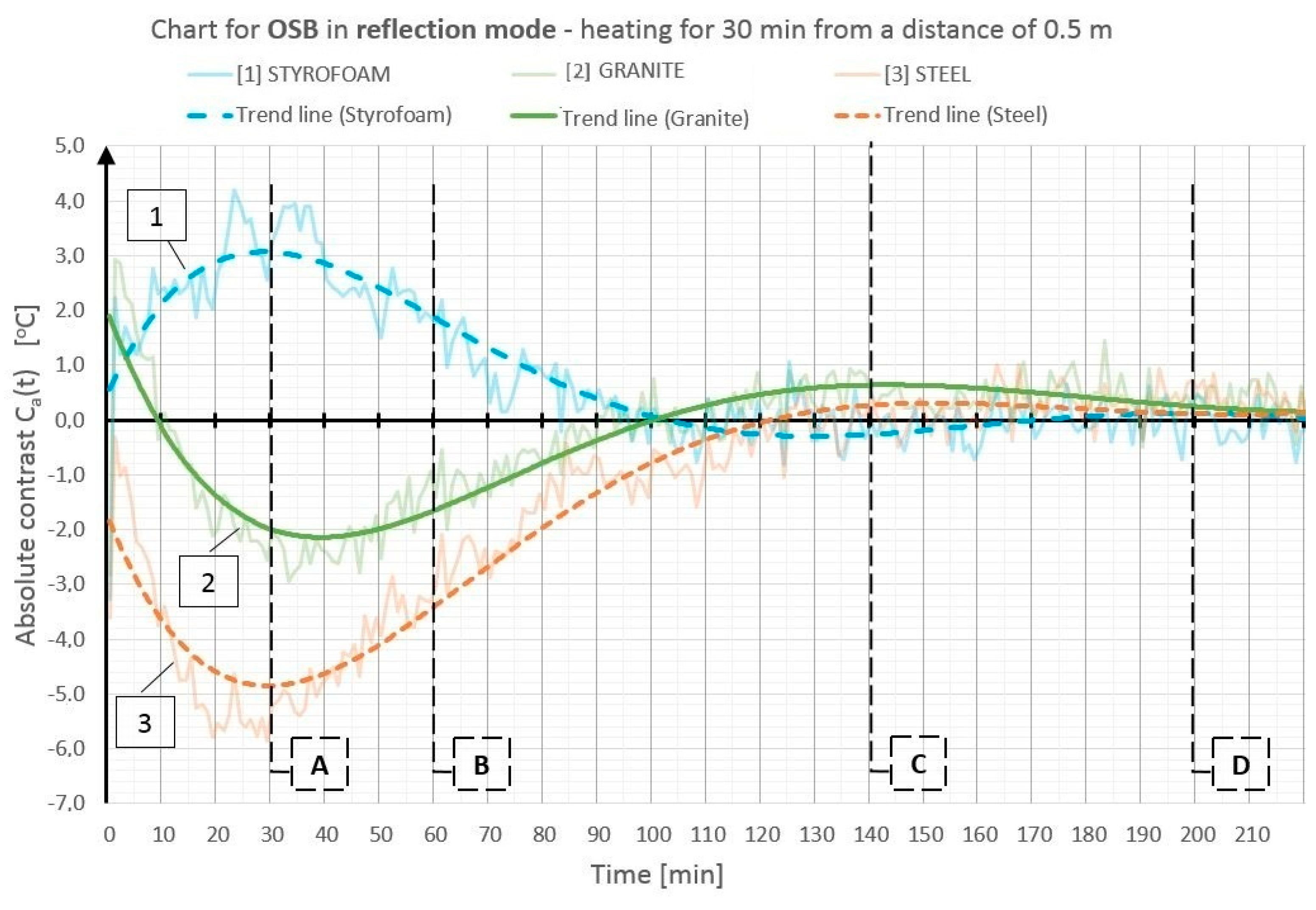
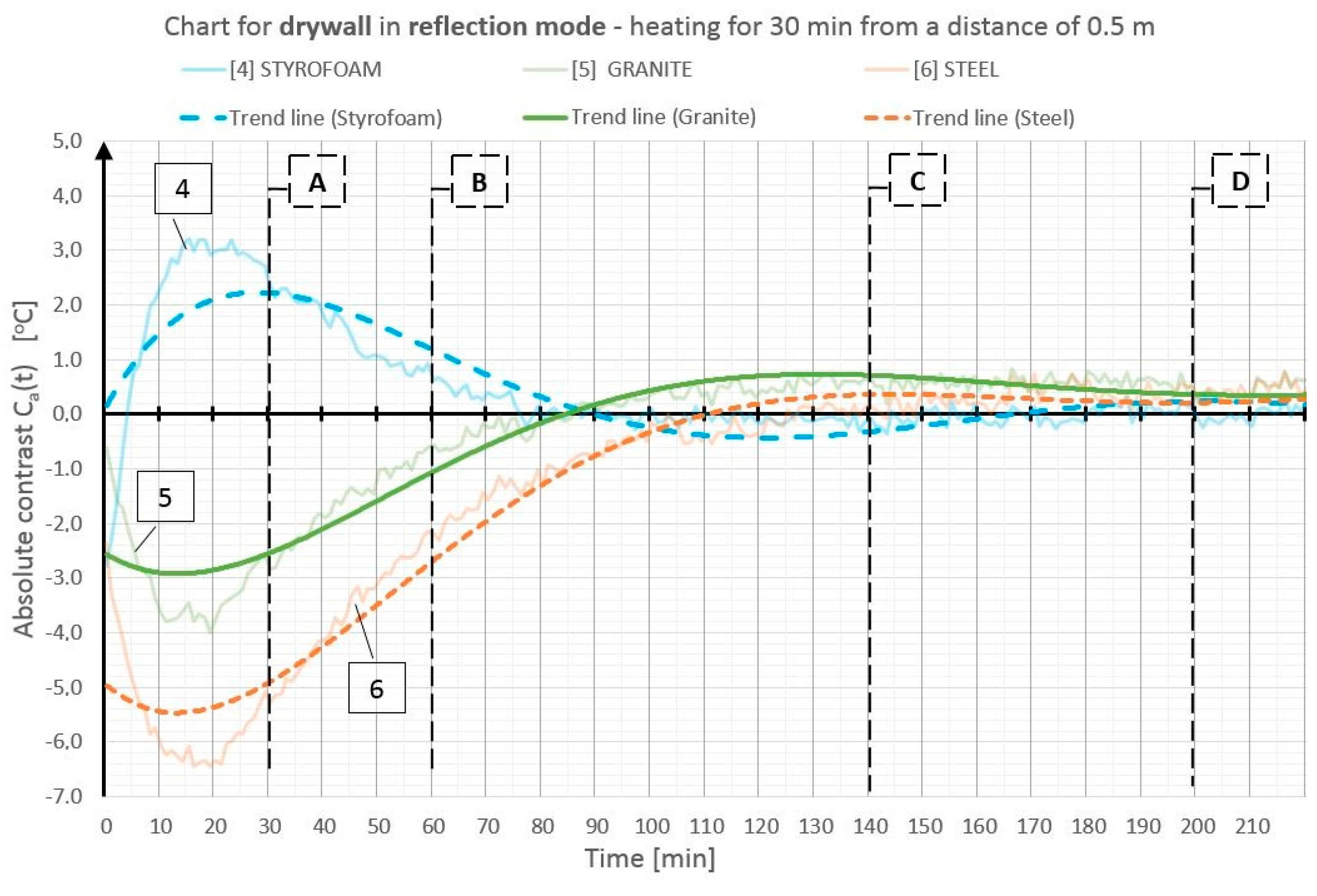
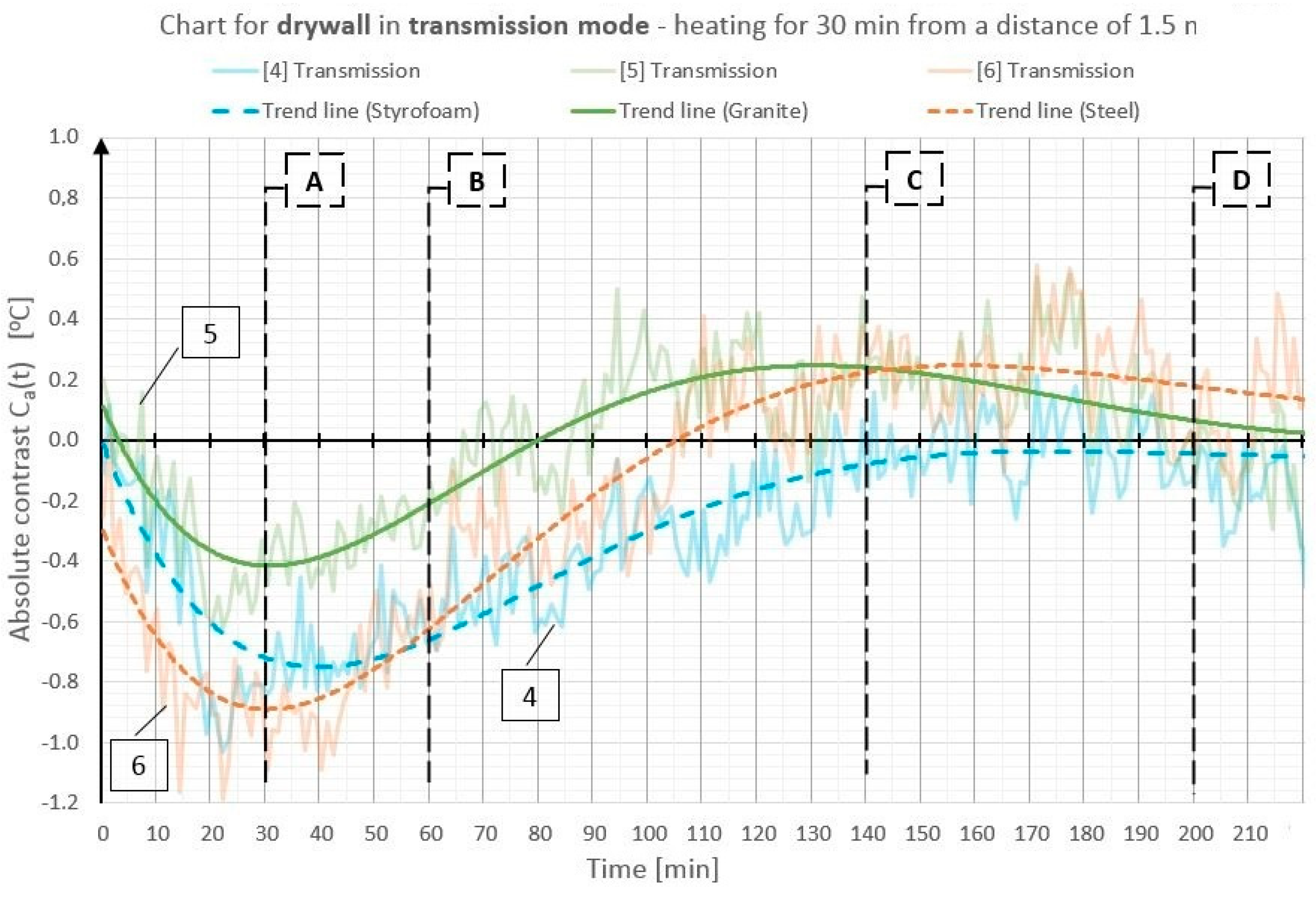
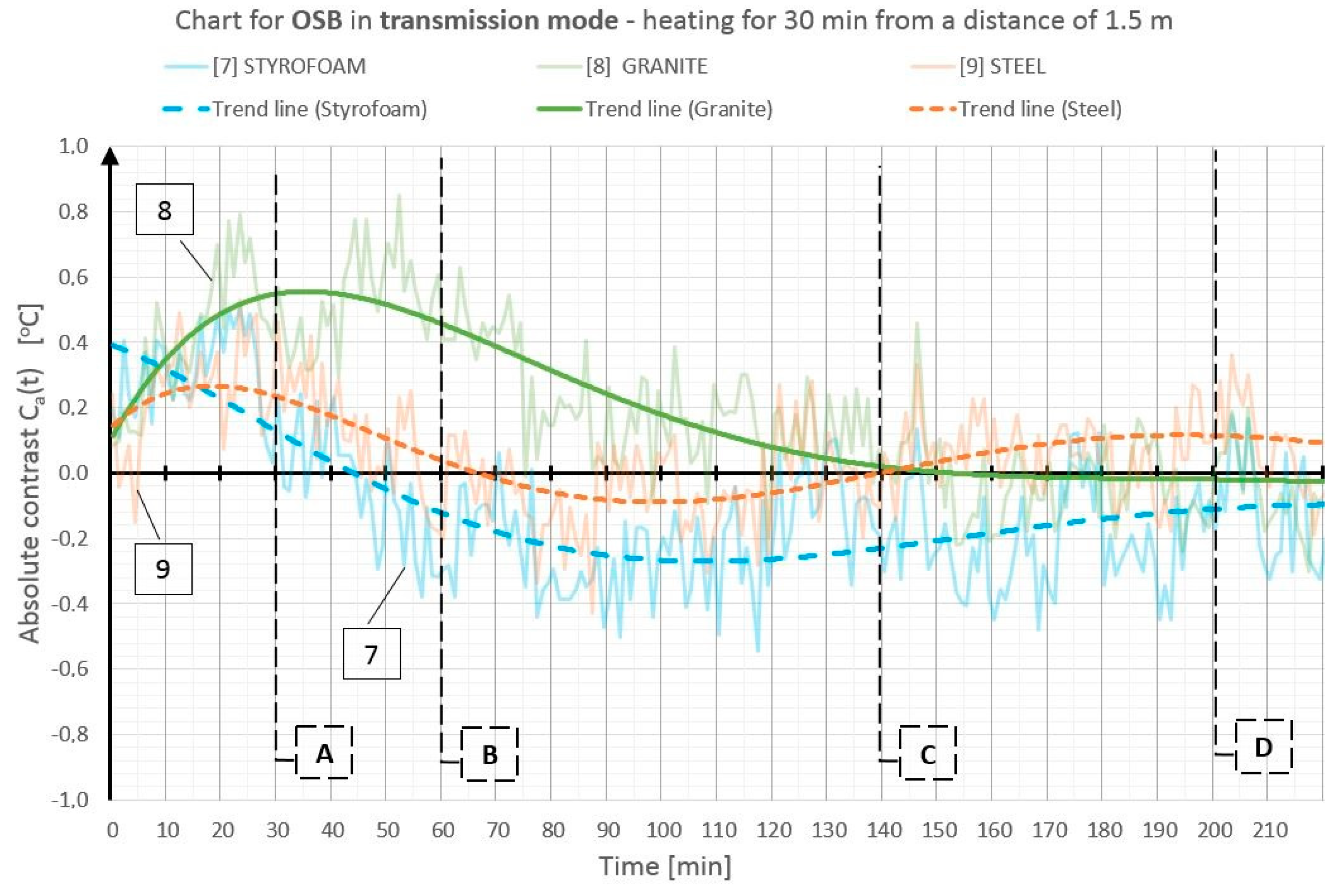

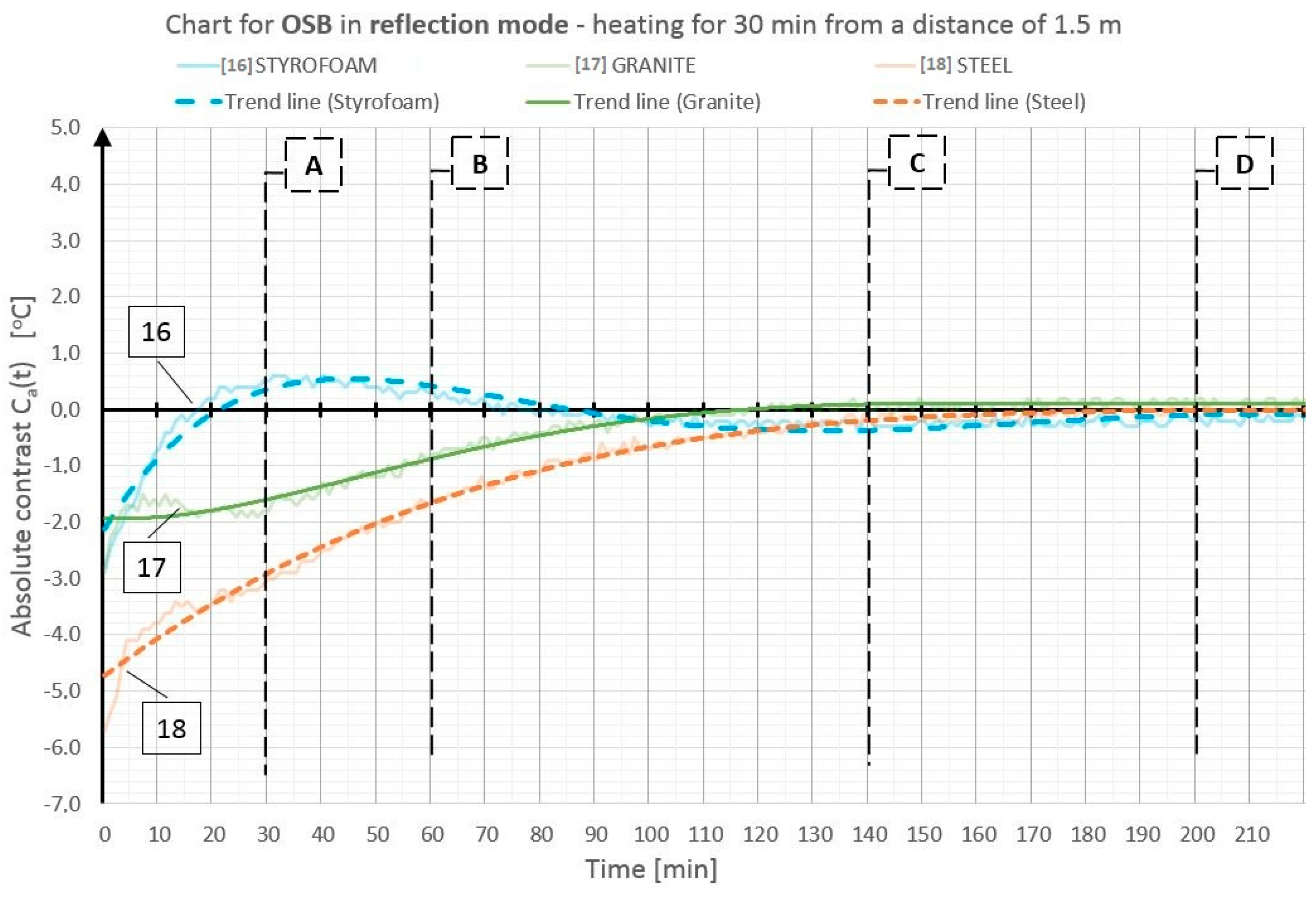

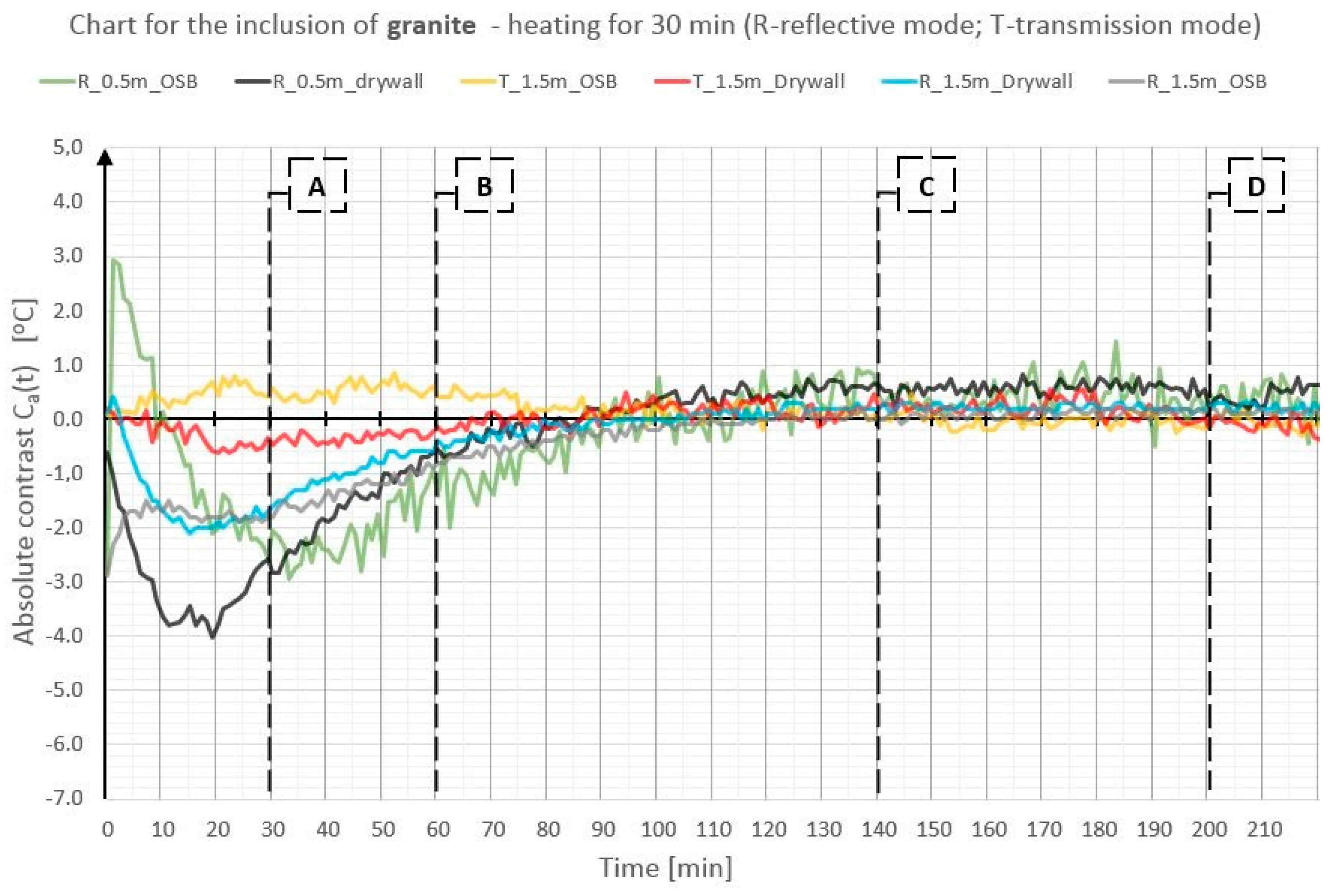
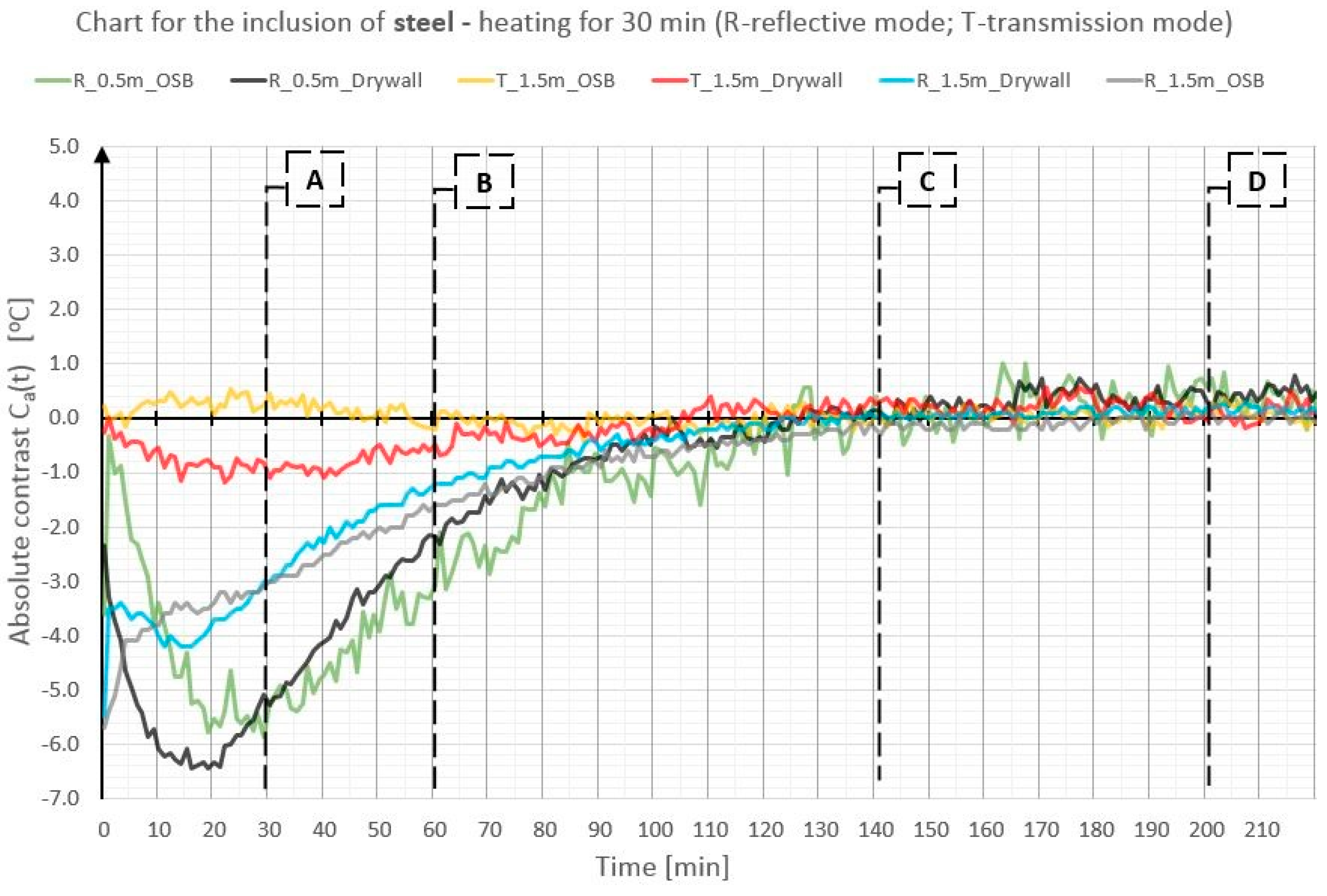
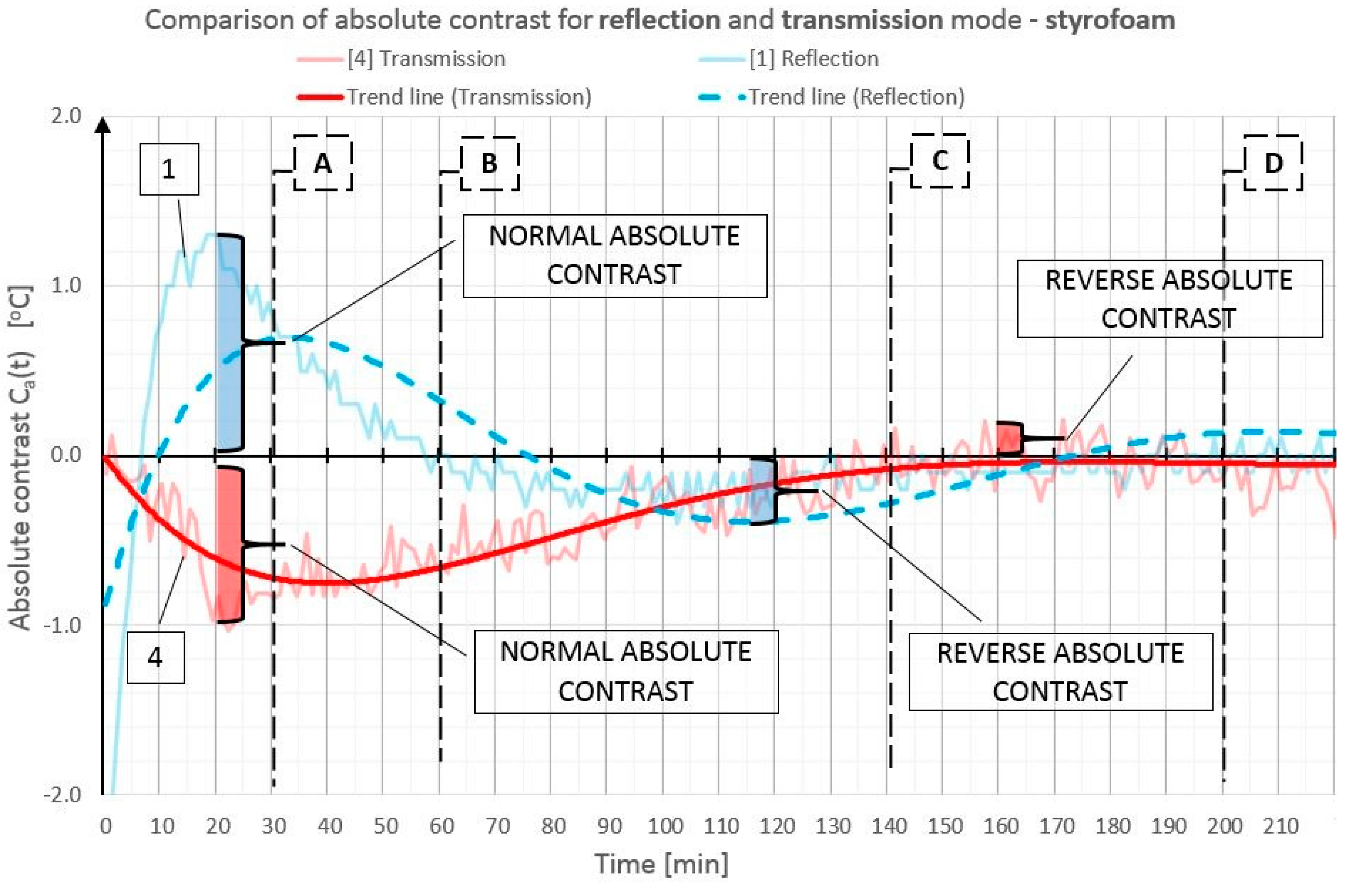
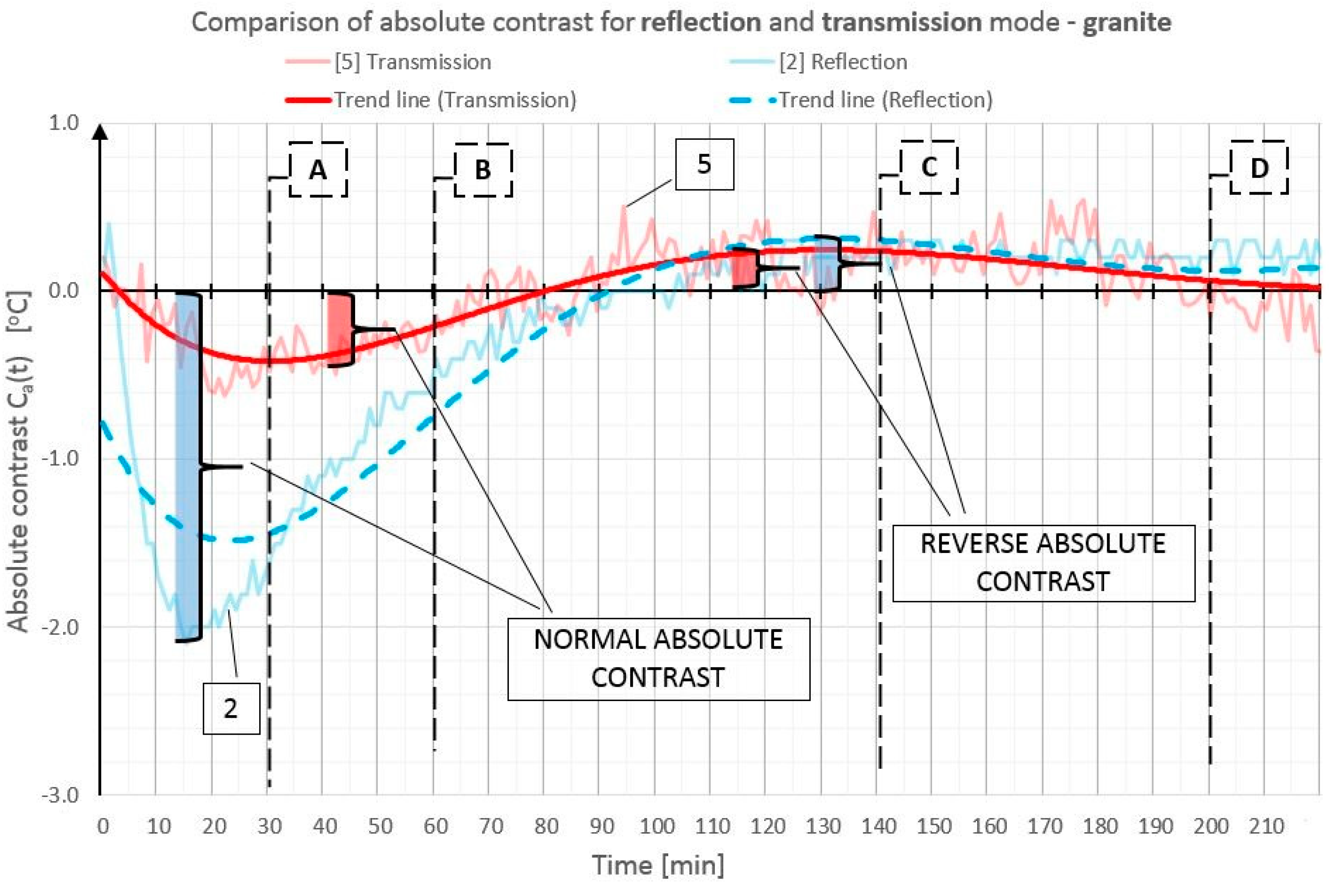
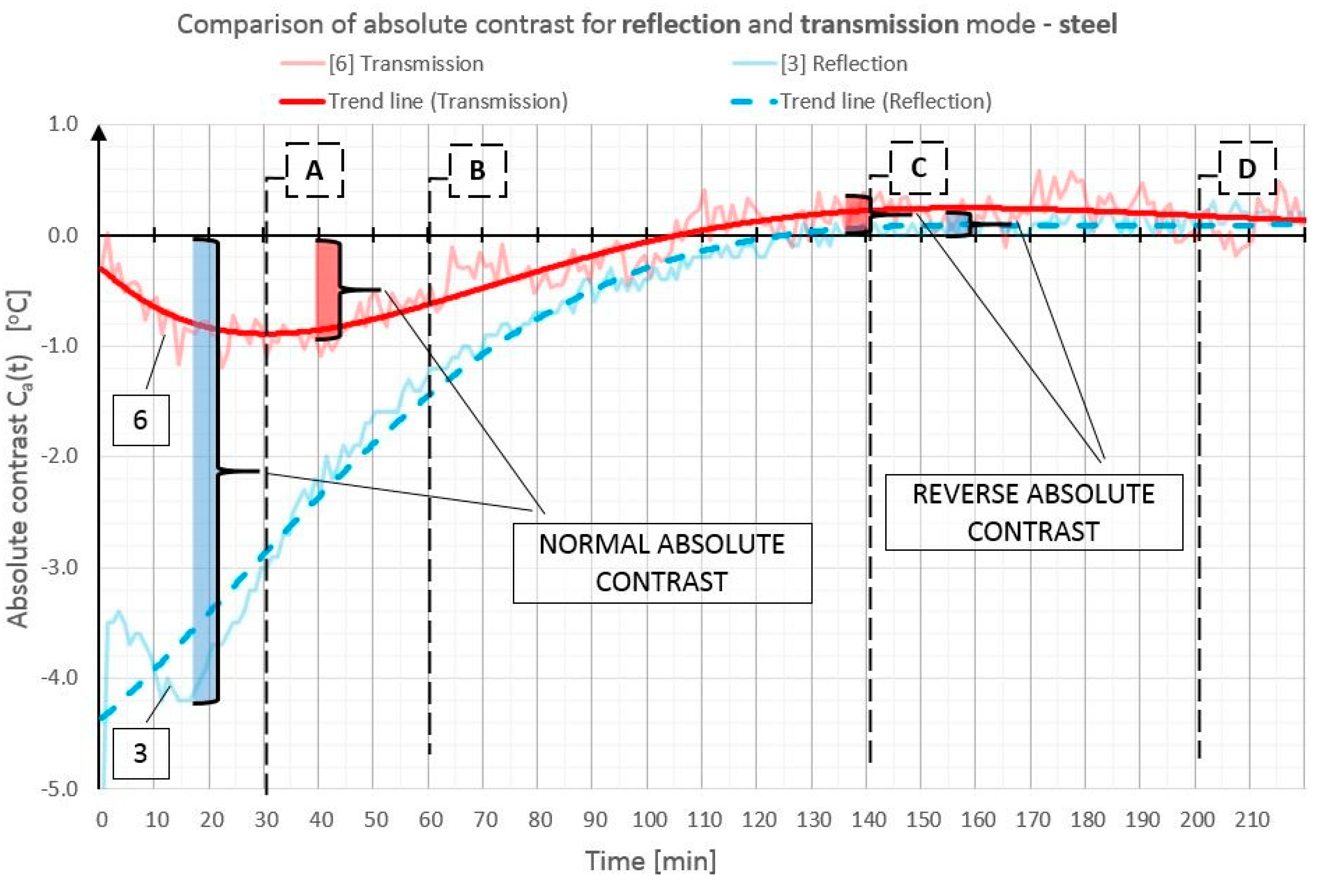
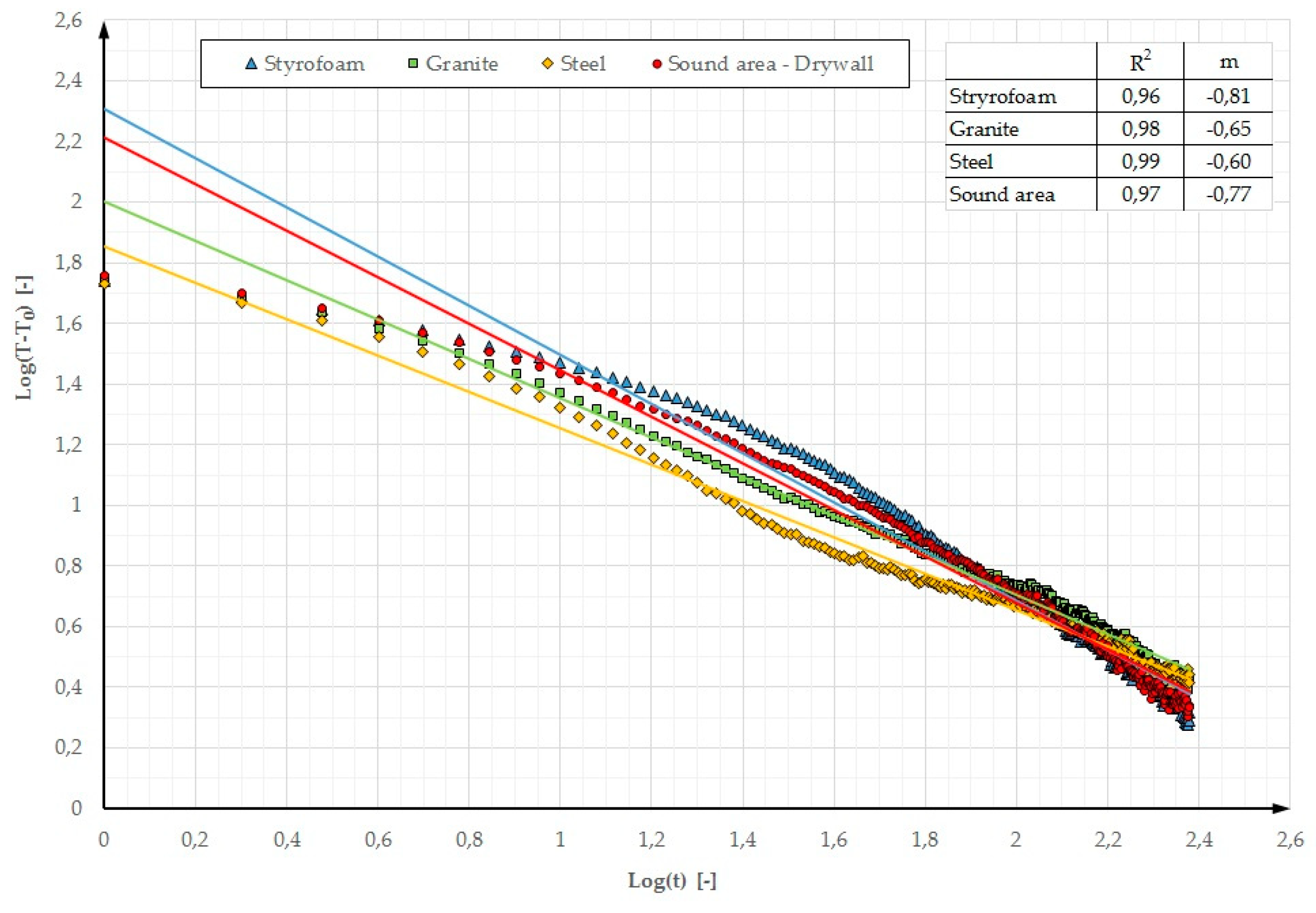

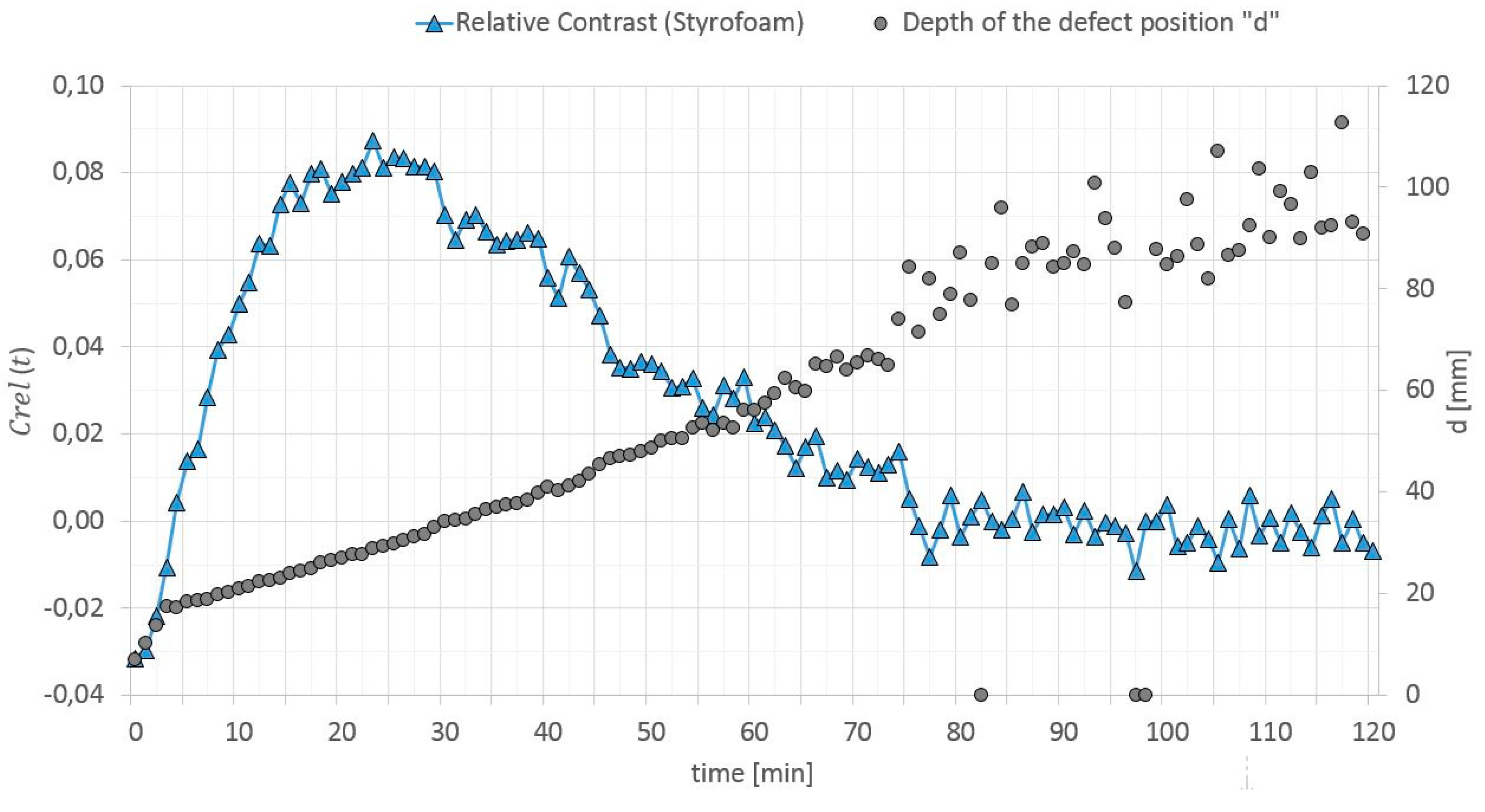
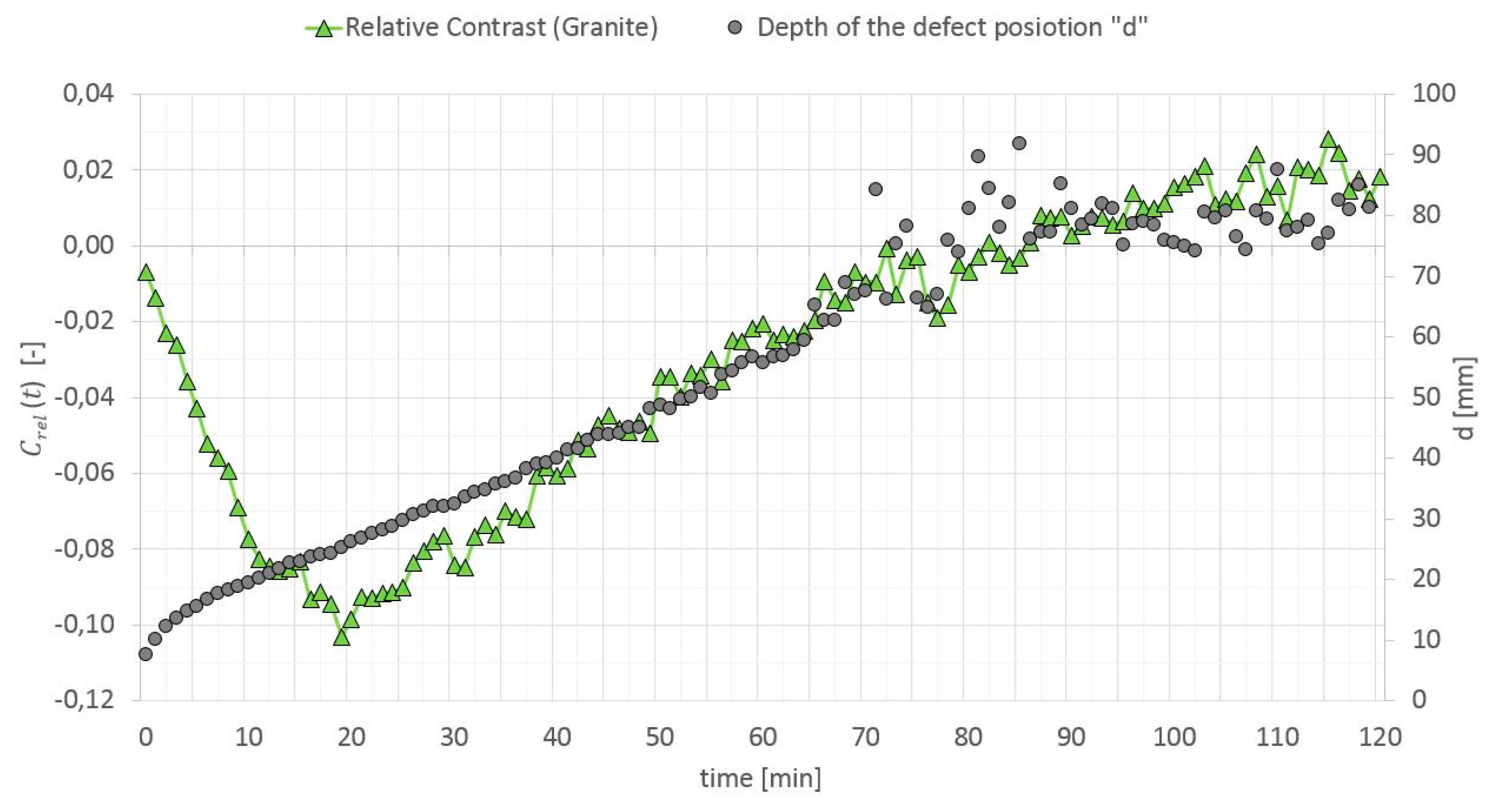

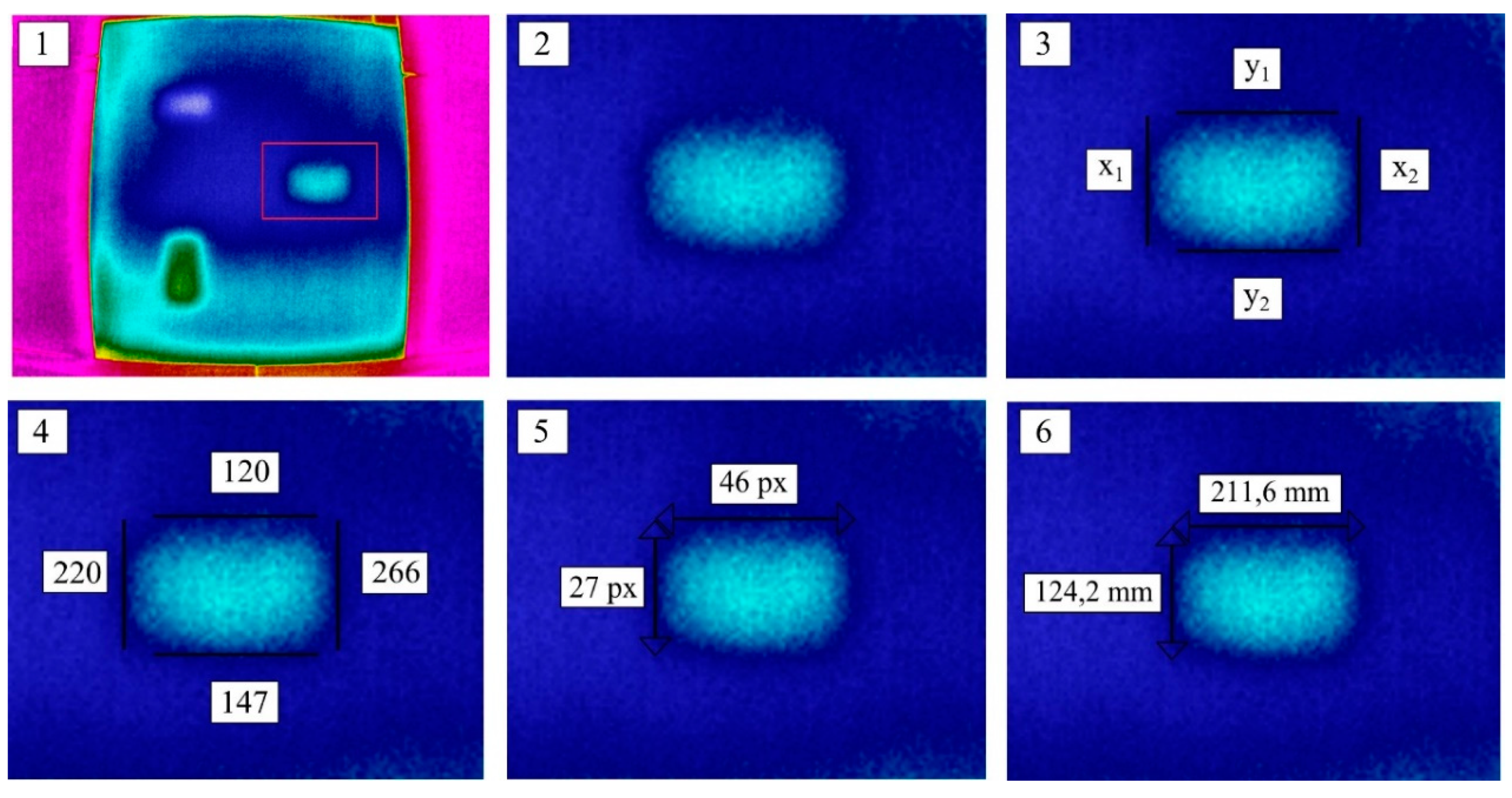
| Type of Material | Bulk Density | Specific Heat | Heat Capacity | Thermal Conductivity | Thermal Diffusivity |
|---|---|---|---|---|---|
| [–] | ρvol [kg·m−3] | cw [J·kg−1·K−1] | Cvol [J·m−3·K−1] | λ [W·m−1·K−1] | a [m2·h−1] |
| Styrofoam | 30 | 1460 | 0.04 × 106 | 0.033 | 0.75 × 10−6 |
| Granite | 2600 | 920 | 2.39 × 106 | 2.80 | 1.17 × 10−6 |
| Steel | 7900 | 500 | 3.95 × 106 | 17.0 | 4.30 × 10−6 |
| GB OSB | 1000 650 | 1000 1700 | 1.00 × 106 1.11 × 106 | 0.23 0.13 | 0.23 × 10−6 0.12 × 10−6 |
| Defect | OSB, Heating from Distance 0.5 m | OSB, Heating from Distance 1.5 m | GK, Heating from Distance 0.5 m | GK, Heating from Distance 1.5 m |
|---|---|---|---|---|
| – | d [mm] | d [mm] | d [mm] | d [mm] |
| Styrofoam | 21.67 | 27.14 | 22.51 | 22.93 |
| Granite | 24.15 | 20.63 | 22.89 | 21.92 |
| Steel | 19.97 | 22.36 | 21.32 | 19.51 |
© 2019 by the authors. Licensee MDPI, Basel, Switzerland. This article is an open access article distributed under the terms and conditions of the Creative Commons Attribution (CC BY) license (http://creativecommons.org/licenses/by/4.0/).
Share and Cite
Noszczyk, P.; Nowak, H. Inverse Contrast in Non-Destructive Materials Research by Using Active Thermography. Materials 2019, 12, 835. https://doi.org/10.3390/ma12050835
Noszczyk P, Nowak H. Inverse Contrast in Non-Destructive Materials Research by Using Active Thermography. Materials. 2019; 12(5):835. https://doi.org/10.3390/ma12050835
Chicago/Turabian StyleNoszczyk, Paweł, and Henryk Nowak. 2019. "Inverse Contrast in Non-Destructive Materials Research by Using Active Thermography" Materials 12, no. 5: 835. https://doi.org/10.3390/ma12050835
APA StyleNoszczyk, P., & Nowak, H. (2019). Inverse Contrast in Non-Destructive Materials Research by Using Active Thermography. Materials, 12(5), 835. https://doi.org/10.3390/ma12050835





